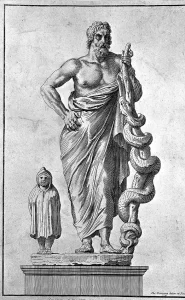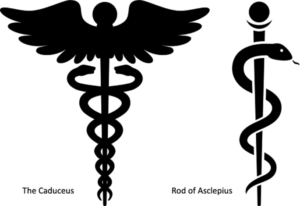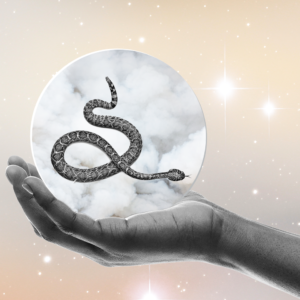Serpents, slithering through the annals of time, have embodied a complex web of meanings. From the dark depths of ancient myths to the symbols adorning modern medicine, the snake symbolism is as layered as it is ancient. This journey into the world of snakes mythology unveils the multifaceted roles these creatures have played across cultures and eras.
The Mystique of Snakes in Mythology
Snakes, revered and feared, have etched their presence in various mythologies. In these ancient narratives, snakes often symbolize transformation and renewal, due to their skin-shedding ability. They represent the cycle of life, death, and rebirth. Greek mythology presents a profound example with the serpent-entwined staff of Asclepius. He was the god of healing, illustrating the serpent symbolism in a benevolent light.
The Birth of a Medical Symbol

The intertwining of the snake symbol with medicine is deeply rooted in the story of Asclepius. Son of Apollo, mastered healing under the centaur Chiron. According to legend, Asclepios observed a serpent using herbs to revive another. Hence, he wielded a staff encircled by a serpent. Because when he watched that snake, he understood that it represents the dual nature of medicine. The capacity to harm or heal, akin to a serpent’s venom and its medicinal potential. This enduring symbol, embodying rejuvenation and ethical healing.

Although the medical symbol was inspired by Asclepios, the Caduceus has its own distinct origins and meanings. Featuring two snakes and wings, this symbol extends beyond medicine, representing commerce and negotiation. But still, it is perfect to see that the modern medicine signifying the deep-rooted connection between ancient wisdom and today.
Decoding Snake Adornments
Adorning oneself with snake motifs isn’t merely a fashion statement. Historically, wearing a snake signified wisdom, fertility, and protection.

In Ancient Egypt, the Uraeus cobra symbolized royalty and divine authority, while in Ancient Greece and Rome, serpents represented healing, as seen in the Rod of Asclepius. Hinduism revered snakes for their spiritual significance in rebirth and transformation. Native American tribes saw them as protectors or symbols of change. Aztecs and Mayans, worshipped the feathered serpent deity, Quetzalcoatl. He was the god of wisdom and creation. This diverse array of beliefs highlights the serpent’s multifaceted symbolism in human history, ranging from protection and power to wisdom and healing.
Serpent as a Spiritual Guide: Beyond the Physical Realm
The spiritual meaning of a snake delves into realms beyond the tangible. In many traditions, snakes are seen as guardians of sacred spaces and knowledge. This belief extends into the concept of Kundalini in Hindu philosophy, where the serpent represents dormant energy at the base of the spine, waiting to be awakened.
The Serpent’s Dual Nature: Symbol of Evil and Good Omen
While often cast as villains in religious texts, symbolizing temptation and evil, snakes was always hold positive connotations. In some cultures, encountering a snake is considered a good omen! A signaling transformation or the beginning of a new life phase.

The shift in perception of snakes from revered symbols of transformation to emblems of fear and evil did not happen in one night. It is a multifaceted process. This transformation is largely influenced by religious narratives. Notably in the Judeo-Christian tradition where the snake is depicted as a deceiver in the Garden of Eden, casting it as a symbol of temptation and evil.
Additionally, the natural danger posed by venomous snakes has instilled an instinctual fear in humans, further reinforcing negative associations. Snakes, with their mysterious, hidden nature, have often been linked to the unknown or chaotic elements of the natural world, leading many cultures to view them as dark and malevolent. Over time, literature and media have perpetuated this negative image, portraying snakes as villains’ best friends.
Dreaming of Snakes: Unveiling the Unconscious
The spiritual meaning of a snake in a dream is as varied as the creature itself. Common interpretations suggest that snake dreams symbolize hidden fears, healing, or significant life changes.

Akin to their natural behavior of shedding skin, snakes in dreams can signify transformation and renewal. This suggests a period of personal growth or a call to discard outdated beliefs and habits. Psychoanalytic theories propose that snakes embody the unconscious mind. So, they are manifesting repressed thoughts, primal instincts, or unacknowledged desires. L Thus, a snake symbolism in a dream is a multifaceted symbol, intertwining fears, growth, unconscious desires, and hidden wisdom.
Embracing Eternity: The Ouroboros Symbol
An ancient symbol depicting a serpent eating its own tail, holds a significant place in the tapestry of serpent symbolism. Originating in ancient Egyptian iconography and later adopted by the Greeks. The Ouroboros embodies the concept of eternal cyclic renewal—the endless cycle of life, death, and rebirth. This symbol reflects the universe’s perpetual nature, continuity, and the eternal return.

In alchemical traditions, it represents the unity of opposites and the harmonious interplay between the foundational elements of existence. The Ouroboros also appears in Gnosticism and Hermeticism as a metaphor for the eternal cycle of life and the soul’s immortality. Its circular form symbolizes the cyclical nature of the universe, suggesting that life and existence are not linear but rather a continuous, repetitive process. This powerful symbol encapsulates the essence of the serpent as a creature of transformation, continuity, and the eternal mystery of the universe.
In conclusion, snake symbolism, manifests in various guises – from a symbol of healing and protection to an emblem of evil and deceit. Its presence in mythology and modern symbolism continues to fascinate and provoke thought, revealing the deep and enduring connection humanity shares with these enigmatic creatures.


[…] body, embodying wisdom and healing. Her story echoing through the ages to the symbol of the caduceus, where twin snakes entwine a staff! A beacon of medical harmony and balance. Snakes’ […]